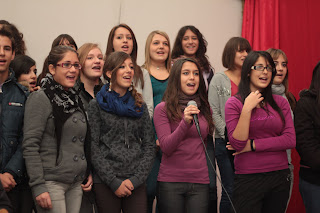Presentation of the movie
LA VITA E' BELLA
Original title: La vita è bella”
Country: Italy
Year: 1997
Director: Roberto Benigni
Genre: Dramatic
Length: 110 minutes
Setting: V. Cerami
Music: P. Piovani
Photography: T. Delli Colli
La vita è bella is a famous film whose director is Roberto Benigni.
We can divide it into two distinct parts: the first, which is typical of a COMEDY, and the second, which clearly shows the DRAMA lived in a concentration camp in Trieste by the Jews in 1930s.
It's the story of Guido, an Italian man, whose origins are Jewish. He lives in Arezzo (Tuscany) and he falls in love with Dora; she likes him too.... They get married and have a child, Giosuè.
Suddenly, Mussolini's racial laws passed and Guido and Giosuè are brought into a lager. Guido knows the huge cruelty of Shoah, but he makes his best every day to let his child believe all what he sees is part of a game, a game where people are eliminated and final prize is a tank.
We can't help being moved by the poet Benigni who, in this film SINGS HIS HYMN TO LIFE, even when the world where he lives is the worst one!!! Guido wants to save his child by horror letting him believe they all are playing.
There is a perfect equilibrium between drama and comedy; the audience cries and laughs at the same time.
Guido is a fantastic father, who even when he is going to die laughs and jokes because he wants his child continues to believe that........ LIFE IS BEAUTIFUL!
STUDENTS' COMMENTS ON THE MOVIE
It is really a moving film, which perfectly faces an event that dramatically affected so many people. Acting is perfect and makes you live each single scene as if you were personally involved in it.
As Primo Levi says “ we have to remember everyday the history of dictatorship and every evening, when our children go to bed, we have not to tell them fairy-tails, but History, so that they can know it and such events will not occur anymore”. This movie does that excellently.
This movie really touches people souls, because it tells the misfortunes of a Jew family, that represents the whole Jewish people and what they had to suffer.
I think that this is one of the most beautiful and the most significant movies of recent years. It is a story that communicates to us the infinite beauty of life, in spite of the tragic period in which it takes place. It deals with such a hard matter with simple and hilarious messages, in a way that only the great Roberto Benigni can do.
After seeing this movie, I have become more and more aware that life is like a mirror: the more you smile at life, the more it will answer with a smile, perhaps not immediately, not the way you would like........but anyway, there will always be something that will make you happy and that will make you appreciate more and more the beauty of life.
Watching the movie, what most impressed me was Benigni's ability in facing the themes of suffering and love. There is a double kind of suffering in the movie: the first related to the imprisonment in a concentration camp, and the second – a greater one - related to the concern of the protagonist for his son's and wife's lives.
One could wonder how it is possible to entitle “Life if beautiful” a movie about the Holocaust! You can't help being moved by the “poet” Benigni, who during the movie sings his hymn to life, even though his world may seem like the worst of all possible worlds. After all, the movie is an extreme act of acceptance of life.
The idea of saving his son from the horror making him believe that everything is a game, is both an original and strong way to blame Nazism.
Love is … a husband who adores his wife and a father who laughs and jokes up to the end, even when he is going to die, in order to allow his son to keep believing in the beauty of life.
What is surprising in the movie is not only its sweetness, but also its ability to arouse emotions and thoughts, without any triviality.
The movie succeeds in describing this huge human tragedy in such an extraordinary lightness, that the audience is drawn into a kind of suspended world.
I think that this kind of movie can teach us to don't have fear of the enemies and I think it has been done to let us understand the meaning of love.




























